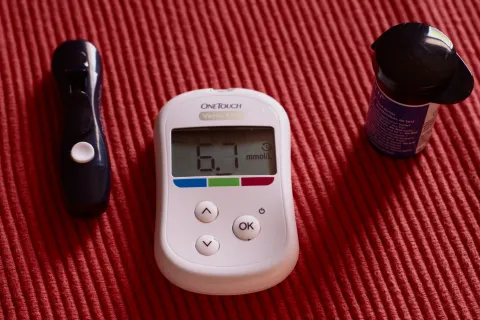ATN@Work: Easing clinic visits for kids with autism
Our Autism Treatment Network center in Los Angeles has proven tips for ensuring a more successful medical visit for you and your child
 By developmental behavioral pediatrician Larry Yin. Dr. Yin is the medical director of the Boone Fetter Clinic at Children’s Hospital Los Angeles, one of 14 centers in the Autism Speaks Autism Treatment Network. Dr. Yin also directs the University of Southern California’s University Center of Excellence in Developmental Disabilities.
By developmental behavioral pediatrician Larry Yin. Dr. Yin is the medical director of the Boone Fetter Clinic at Children’s Hospital Los Angeles, one of 14 centers in the Autism Speaks Autism Treatment Network. Dr. Yin also directs the University of Southern California’s University Center of Excellence in Developmental Disabilities.
Most children feel a little anxious about seeing a doctor. Some fear even temporary separation from their parent. Others worry about a painful shot, or just the unknown.
As regular readers of this blog column know well, children with autism may have all these fears plus the additional challenges of sensory issues with a new environment. Just think of all the new smells, sounds, lights and new faces a patient encounters in a medical clinic.
We’ve learned from experience that the understandable anxiety that develops before a visit can boil over during the visit. In addition to creating great stress for the child, this can interfere with much-needed evaluations and medical procedures. In the worst case, a visit may have to be rescheduled – a potential hardship on both the child and his or her family.
At our clinic, we’ve developed a number of strategies to help ease visits for children who have autism and their families. I’m pleased to share some of them with you –with the hope that they can help ease your child’s next medical visit and lead to more effective communication between you and your child’s provider:
Scheduling your appointment
We understand that waiting can present a particular challenge for our young patients with autism. Whenever possible, we suggest asking for the first appointment of the day or the first appointment after lunch. This can reduce the sometimes-unavoidable wait times that build up through the day when a doctor needs to spend extra time with patients.
Another wait-reducing tip: Ask, ahead of time, for the clinic staff to fax or email you any forms that need to be filled out before you see the doctor. Conversely, we suggest you send ahead any forms you need filled out – for example, school forms.
Preparing for the visit
Click here for a sample frame from “Going to the Doctor,” free a social story. Ask ahead of time about what tests and procedures to expect. Will they include blood work or shots? With this in mind, there are a number of ways to ease any anticipated anxiety.
1) Develop a social story to prepare your child for the visit. Social stories are an excellent way to help explain new situations to kids – and adults – on the autism spectrum. Typically, they’re visual stories that walk the reader through particular situations. Autism Speaks and Microsoft Office recently partnered to create a suite of social stories for helping children with autism deal with new situations. You’ll find one on preparing for a doctor’s visit here.
2. Role playing is another great way to ease anxiety. This can be as simple as a little make-believe visit to the doctor’s office. You and your child take turns playing the people you’ll meet.
3. Several days before the appointment, create a visual schedule for the day. With a visual schedule, you have a picture for each step. For example, a picture of a car – for “we drive to the clinic.” You park. You go into the lobby. You find the doctor’s office and check in with the receptionist, and so on. The Autism Speaks ATN/AIR-P Visual Supports Tool Kit can help.
 The Autism Speaks ATN/AIR-P Visual Supports Tool Kit can help. Download it free of charge (link in main text).You can go over the visual schedule at home as many times as your child would like. Then give it to your child when it’s time to go to the clinic. At the doctor’s office, help your child check off the steps.
The Autism Speaks ATN/AIR-P Visual Supports Tool Kit can help. Download it free of charge (link in main text).You can go over the visual schedule at home as many times as your child would like. Then give it to your child when it’s time to go to the clinic. At the doctor’s office, help your child check off the steps.
4. Is this going to be your child’s first time at a new office? Consider a brief visit beforehand just to allow your child to meet and say hello to the front office staff and see the play area in the waiting room. He or she may well look forward to returning!
5. Practice calming exercises and activities such as deep breathing or using a squeeze ball during periods of stress.
 A sample visual schedule for a clinic visit, courtesy Vanderbilt University Medical Center.6. If the office welcomes email, consider e-mailing ahead any questions you have and ask that they be placed in your child’s medical file for the doctor to see. Print out a copy to bring with you as well. It’s so easy to get distracted during the visit – especially when you’re focused on calming your child. The written list will help ensure you get all your questions asked and answered.
A sample visual schedule for a clinic visit, courtesy Vanderbilt University Medical Center.6. If the office welcomes email, consider e-mailing ahead any questions you have and ask that they be placed in your child’s medical file for the doctor to see. Print out a copy to bring with you as well. It’s so easy to get distracted during the visit – especially when you’re focused on calming your child. The written list will help ensure you get all your questions asked and answered.
Things to bring
1. In addition to that list of questions, consider using your cell phone or other video recording device to capture any new behaviors of concern to you. At our clinic, we encourage parents to email these video clips along with their questions in advance. 2. A written list of any medications and nutritional supplements that your child is taking.
3. A list of your child’s healthcare providers, including therapists, and their contact information (phone numbers, email). This helps us make sure your child’s healthcare team is coordinated and working together to address your child’s needs.
During the Visit
1. Bring comfort items or activities that might help redirect your child from his/her fears
2. Use the relaxation techniques you practiced beforehand. (See above.)
3. If possible, consider bringing another adult to help during the visit – someone who can either help comfort your child or help you record the answers to your questions.
4. Remember to share the lists of medications/supplements and healthcare providers with your doctor. This way we can update your child’s records and reach out, as needed, to speak with your child’s other providers.
After the Visit
1. Praise, praise, praise your child for his or her successes during the visit.
2. Review the answers to your questions
Remember, you know your child best. We hope you’ll adapt these strategies to help make your child’s healthcare visits successful.









